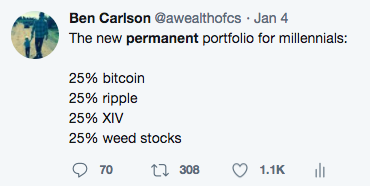The original permanent portfolio was created by Harry Browne and consists of the following allocation:
- 25% in U.S. stocks
- 25% in long-term bonds
- 25% in gold
- 25% in cash
The idea behind this portfolio is that it’s diversified enough to get you through a wide variety of economic and market environments and simple enough that even a caveman could do it.
There are holes you could poke in this allocation but that’s true of any portfolio or investment strategy. The first step in investing is figuring out a philosophy and strategy that works for you. Steps 2 through 100 are dealing with the drawbacks of said strategy and sticking with it through the rough times when it makes you feel stupid for doing so.
The backtests on the permanent portfolio aren’t bad but it doesn’t really matter what a backtest says if you’re constantly tempted to switch strategies. Backtests assume you stay invested and don’t tinker. Front tests prove that most (all?) investors do tinker.
Earlier this year I tweeted out the following (with tongue planted firmly in cheek):

Since this facetious tweet was sent:
Ripple went from $3.20 to $1.03 (-68%)
Bitcoin went from $15,299 to $8,642 (-44%)
The Alternative Agroscience ETF (MJX) went from $35.47 to $32.20 (-9%)
XIV went from $142 to, well, $5 and change which next week will be nothing (“termination event”)
The point of this tweet was to highlight many of the fad investments that had been garnering headlines because they had experienced such huge gains. I didn’t realize we would see such huge declines in these assets (save for pot stocks) but that’s a risk you take when investing after seeing such huge ramps in price.
There’s nothing wrong with chasing trends per se if that’s your thing but most investors do so in an unsystematic fashion with no rhyme or reason behind it. There’s a difference between trend-following and performance chasing.
There is no such thing as a permanent portfolio for the majority of investors because circumstances change over time — life events, your financial situation, family, responsibilities, work, spending habits, risk profiles, the ability, need, and desire to take risk, etc.
Plus there are now more investing options available than ever before. There will continue to be new products, strategies, cost structures, and platforms to invest in. This presents a paradox of choice for the technologically savvy young person because they will be tempted more than ever to trade, buy, sell, and change things up.
Just look at the message I saw recently on my handy Robinhood app:

They’re begging people to trade cryptos 24/7. It looks like a freaking video game (and maybe it is in some ways).
This is likely just the beginning for young people in terms of near unlimited choice in their investment options. As technology improves and the asset management industry evolves we’re going to see much more of this. The ease of access to investing products will be unmatched in history but an increase in the number of choices is not always a good thing for consumers. Millennials are going to have to be more vigilant than ever to stay in their own lane and avoid the trappings of thinking that the grass is always greener.
There is no such thing as a true permanent portfolio but if I had to guess, I’d say these are the things the majority of millennials will invest in over the coming years:
- Housing
- Childcare
- Index funds & ETFs
- Themselves
Investment opportunities will come and go but personal finance is the one constant.
Further Reading:
Investing in Yourself Even When It Seems Irrational
A Good Lesson For Millennial Investors
